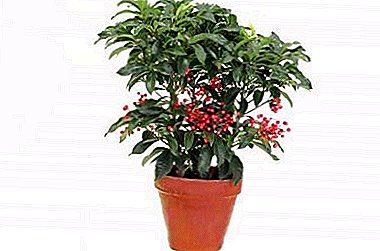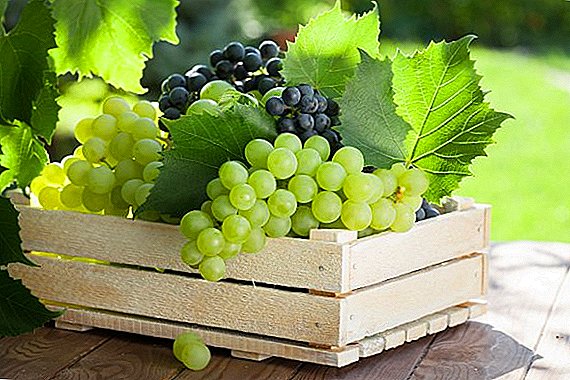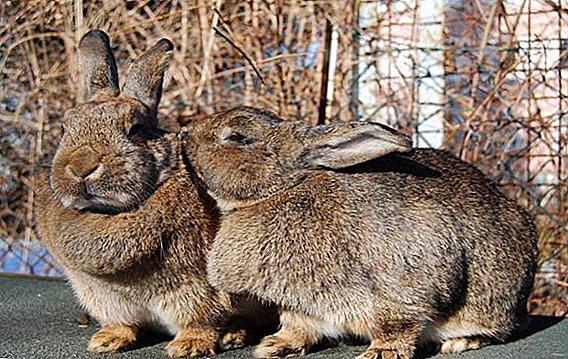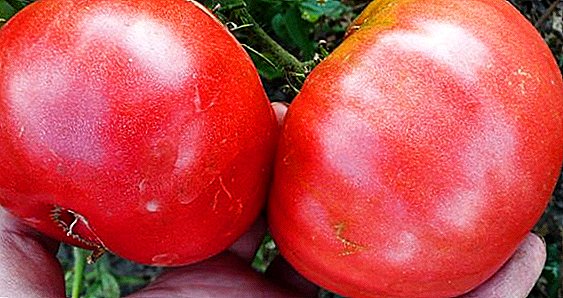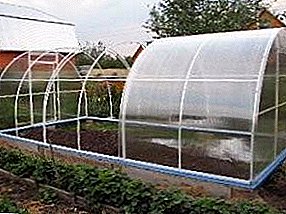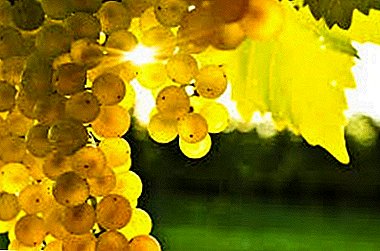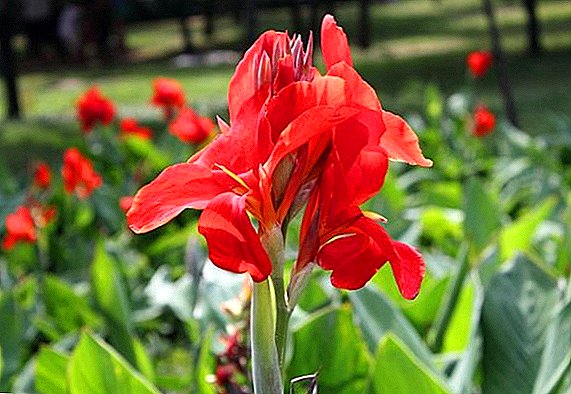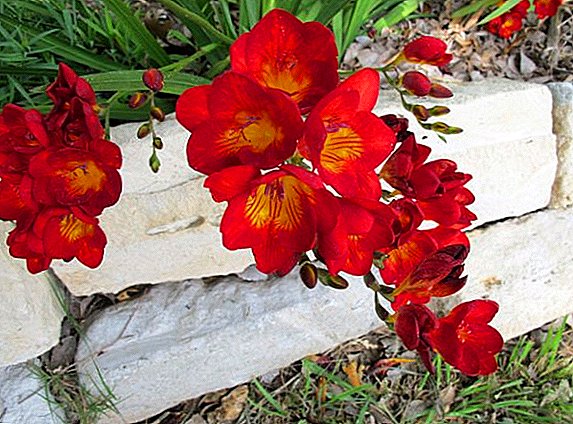 What only epithets do not find people in describing the aroma of freesia. But every time they get into a quandary. Because there are no such words. In the article, it is impossible to convey her magical aroma, but the description of the flower, the rules of planting and the many nuances of caring for it will help you grow freesia flowers, and this is how it all looks in practice.
What only epithets do not find people in describing the aroma of freesia. But every time they get into a quandary. Because there are no such words. In the article, it is impossible to convey her magical aroma, but the description of the flower, the rules of planting and the many nuances of caring for it will help you grow freesia flowers, and this is how it all looks in practice.
Freesia: flower features
Freesia originates from South Africa, and a significant part of their species comes from the Cape floristic region (extreme south-west of the African continent) - the richest with vegetation on the earth (not to be confused with the Cape geographical region) due to the Mediterranean climate with the reverse temporal position of the seasons (winter - June - August). Two of the freesia species have found distribution in the African tropics, and the northernmost distribution reaches Sudan.
Did you know? Modern floristics distinguishes the zones of the earth's surface according to the content of flora, the difference in the peculiarities of its formation and evolution. This division is built hierarchically, and at the top of this hierarchy, the most significant objects are floristic kingdoms, including floristic sub-kingdoms, regions, subregions, etc. The Cape floristic kingdom is the smallest of all floristic kingdoms.In the places of its origin, the freesia, attributed by botanists to the Iris family, finds its favorite places among the abundance of shrubs along wet shores.
 Among florists, it is often the hybrid freesia (Freesia hybrida) that is used for breeding garden flowers. She was derived experimentally from the following varieties:
Among florists, it is often the hybrid freesia (Freesia hybrida) that is used for breeding garden flowers. She was derived experimentally from the following varieties:- F. refracta - fractured freesia;
- F. leichtlinii - Leuchtlin freesia;
- F. armstrongii - Armstrong freesia.
The genus Freesia was named after the doctor Friedrich Frese (Germany, 1795-1876), who cultivated this plant. It is wrong to carry out the identity between the Freesia genus (Freesia) and the Frizeian genus (Vriesea), located in the Bromeliad family.
Where to plant a freesia, conditions for growing a flower
 In greenhouses and greenhouses, it is easy to create the necessary environment for the breeding of freesia, although such an occupation can only be considered experienced and professional gardeners. It is possible to grow a freesia all year round, but in the cold winters of mid-latitudes its tubers cannot winter; they must be removed from the ground and laid for winter storage. For many gardeners will be relevant information on how to grow a freesia in the garden. For planting freesia in gardens, you must first find a place in the penumbra, besides protected from the winds. There is no need to worry about the soil - any will do. The main requirement for it is looseness and drainage.
In greenhouses and greenhouses, it is easy to create the necessary environment for the breeding of freesia, although such an occupation can only be considered experienced and professional gardeners. It is possible to grow a freesia all year round, but in the cold winters of mid-latitudes its tubers cannot winter; they must be removed from the ground and laid for winter storage. For many gardeners will be relevant information on how to grow a freesia in the garden. For planting freesia in gardens, you must first find a place in the penumbra, besides protected from the winds. There is no need to worry about the soil - any will do. The main requirement for it is looseness and drainage.
In early August, one to three peduncle sprouting occurs from each freesia bulb. In good weather, the bloom can last until October. Pruning flowering bulbs in a pot, container or pot. When frosts come, they are transferred to heat, and fragrant freesias will still delight you for a while.
After digging the freesia bulbs, they are first stored for thirty days at 25 ° C in a room with airing and sufficient dryness. In the future, it is necessary to lower the temperature of the content to 10 ° C. When using other temperature rules, there is a lack of formation of freesia inflorescences in many tubers, a complete set of rules for planting and caring for which must be strictly followed.
Freesia and light
 For good health freesia in indoor areas prefers bright lighting, without shading from the direct rays of the sun. The most suitable location for it is the east and west windows. The northern direction will not provide the amount of light needed for normal vegetation activities. Therefore, additional lighting should be provided in winter and autumn.
For good health freesia in indoor areas prefers bright lighting, without shading from the direct rays of the sun. The most suitable location for it is the east and west windows. The northern direction will not provide the amount of light needed for normal vegetation activities. Therefore, additional lighting should be provided in winter and autumn.
Temperature and humidity for the plant
In addition to controlling the lighting, there are other general rules that suggest, especially to beginners, how to grow flowers and freesia in particular.
For proper maintenance of the freesia, fully ventilated rooms with a temperature of 20 to 25 ° C are necessary. During the period of flowering in freesia, a period of rest (sleep) begins, and the plant needs to lower the temperature to 15 ° C for a period of up to two months. Excessive moisture in the soil is unacceptable, otherwise there will be a rotting of the bulbs. The time of keeping cool during sleep is characterized by the absence of irrigation. The freesia carries dry air normally, but the hot weather requires regular moistening and spraying.
How to plant a freesia
 Before the freesia is planted in the garden, it is necessary to understand how to prepare the freesia for planting. By the beginning of March corms are prepared, placed in pots containing sod earth, sand, peat and humus. The volume of three liters will have six freesia bulbs, which will be in the earth mixture for about 18 days indoors at a temperature of 25-28 ° C.
Before the freesia is planted in the garden, it is necessary to understand how to prepare the freesia for planting. By the beginning of March corms are prepared, placed in pots containing sod earth, sand, peat and humus. The volume of three liters will have six freesia bulbs, which will be in the earth mixture for about 18 days indoors at a temperature of 25-28 ° C.
Did you know? Freesia - a female name, possibly derived from freziya, from the Hunnish language. Men like a magnet are attracted to women with this name.Planting freesia in the open ground is made after passing the threat of night frost. Wells are prepared at the rate of planting at a depth of 3-6 cm. The distance between large tubers is 5 cm, between smaller ones - 3 cm. Row spacings are arranged one behind the other from 15 cm. To protect the soil from overheating, it is mulched with needles or peat. By August 1-3 germs will appear, and by the beginning of October the freesia will bloom.
How to care for freesia in the open field
Particular attention in the cultivation of freesia in open field is paid to maintaining optimal moisture balance by mulching. At the same time, they use soft neutral peat, covering them with a 3 cm layer of soil. You can also use steamed straw for this. In addition to mulching, it is necessary for weeding freesia and loosening the soil to optimize the penetration of oxygen. Flowering freesia in the garden lasts up to one and a half months. Achieve an increase in this period by cutting one-third of the stem when cutting flowers.
How to water a freesia
 During the breeding of freesia in the garden gardeners provides a special mode of watering. Freesia is abundantly and regularly watered during growth and flowering, which lasts up to six weeks. During this season, the ground should always be wet. In addition, they sprinkle both the stems and leaves of the plant. These procedures are best done in the evening, so that the flowers have time to absorb moisture. After the end of the blooming period, the irrigation intensity decreases to a complete cessation. In open ground in the garden freesia kept until frost.
During the breeding of freesia in the garden gardeners provides a special mode of watering. Freesia is abundantly and regularly watered during growth and flowering, which lasts up to six weeks. During this season, the ground should always be wet. In addition, they sprinkle both the stems and leaves of the plant. These procedures are best done in the evening, so that the flowers have time to absorb moisture. After the end of the blooming period, the irrigation intensity decreases to a complete cessation. In open ground in the garden freesia kept until frost.
Important! Freesia requires special care when planting and caring for it in open ground.
Freesia fertilizer
When growing freesia, it is necessary to enrich the soil with superphosphates (for 10 liters of water 35 g) or potassium salts (for 10 liters of water 10 g) at least twice within 30 days. At freesias there is no necessary resistance to salinity of soil, therefore, it is better to carry out its fertilizer only with liquid solution, having refused use of dry mixes.
During active growth, freesia requires four times to make mineral bait with a large amount of nitrogen. When grown in open ground, it is necessary to use such a tactic of fertilizer application, due to which the initial supplementation with ammonium nitrate solution (20 g per 10 l of water) is necessary when shoots appear, and then every two weeks additional fertilizer is added with the addition of water to the same volume of 40 g superphosphate and 20 g of potassium salts.
Freesia support in the garden
 Freesia peduncles, being rather weak and easily bend, feel the need for supports. A small grace of curvature does not take away beauty from flowers, but rather add charm, but in order to avoid breaking off with further growth they are tied to supports. For this purpose, a grid is installed, tying it with a string when the freesia reaches a height of 150-200 mm.
Freesia peduncles, being rather weak and easily bend, feel the need for supports. A small grace of curvature does not take away beauty from flowers, but rather add charm, but in order to avoid breaking off with further growth they are tied to supports. For this purpose, a grid is installed, tying it with a string when the freesia reaches a height of 150-200 mm.
The installation of supports for freesia is necessary to help the plant to maintain its vertical position, since freesias need to grow in conditions of even air distribution and light. This can be achieved only due to the absence of a strong curvature of flower stems. While setting up the grid, one should not forget to keep the width between the cells about 10-15 cm. With an increase in the growth of flowers in height, the following levels are added to the grid or simply lift it, moving it over the supports.
Important! Freesia needs support as it is a fragile and fast-growing plant. Keep in mind that the freesia with yellow-red flowers grows even faster than specimens with other colors.
Diseases and pests of the flower
Freesias are plagued by the same diseases and pests to which gladioli are also susceptible. Incorrect care can cause freesia damage with thrips, spider mites, aphids. But most often freesia suffer from diseases such as rot, fusarium and scab. Immediately affected plants should be removed immediately. For the prevention of the same bulbs can be disinfected immediately after digging and cleaning from contamination. Before planting, decontamination is repeated. It is recommended to use a weakly concentrated solution of potassium permanganate.
During the season, the freesia is sprayed twice with soap and water to avoid the appearance of aphids or mites. When the same rot on the leaves of plants they need to be treated with a solution of manganese or "Fundazole."
How freesia multiplies
 Reproduction in freesia occurs tuber buds, seeds and corms. In itself, the corm is an escape with the buds of the next year with buds in the upper part. The purpose of corm is to store nutrients.
Reproduction in freesia occurs tuber buds, seeds and corms. In itself, the corm is an escape with the buds of the next year with buds in the upper part. The purpose of corm is to store nutrients.
During one vegetative period, the old corm is replaced by a completely new one, and it also forms one or several tubers ("babies") at the base, which, when rearing, turn into new corms.
Reproduction by seeds is carried out with selective reproduction, as well as from insufficiency of planting material. Freesia seeds are sown in the period from the second half of April to the beginning of June in two or three doses, pre-soaking them throughout the day in a pink solution of potassium permanganate. Sowing is carried out in picking boxes or in racks with a mixture of humus, sod and leaf earth, or in compost for greenhouses. After about 25 days at a temperature of 20-22 ° C (it is also possible in a dark place) mass shoots appear.
Important! With all the difficulty in growing freesia, the result is quite achievable, though not for the lazy. But he is worth it!


